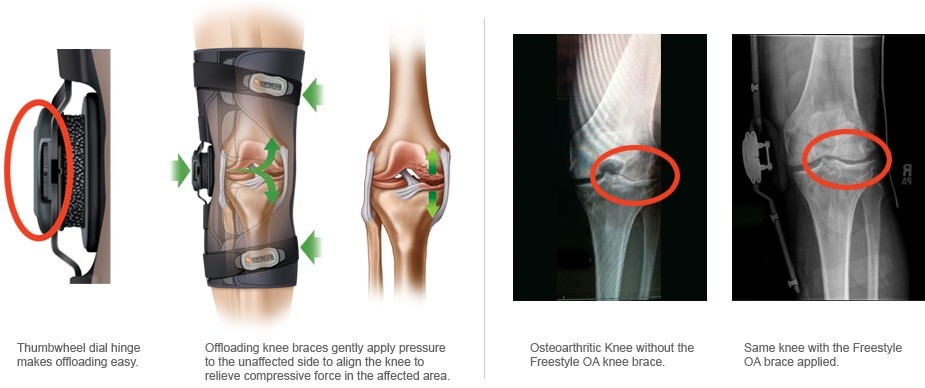
Osteoarthritis (OA) is like an unwelcome guest in many adults’ lives, bringing pain and stiffness to joints that used to move freely. As we age, just like the soles of a well-worn pair of shoes, the cushioning in our joints, known as cartilage, begins to wear down. This condition affects millions worldwide and is often referred to as the “wear and tear” arthritis. In this article, we’ll break down what osteoarthritis is, how it affects your life, and how something as simple as a knee brace, particularly the Freestyle OA, can help manage its symptoms.
What is Osteoarthritis?
Imagine the cartilage in your joints as a sponge. In a healthy joint, this sponge is thick and springy, helping your bones glide over each other smoothly. But in an osteoarthritic joint, this sponge is worn down, thin, and rough. When the protective cartilage is worn away, bones rub against each other, causing pain, swelling, and difficulty moving. While it can affect any joint, the most commonly affected areas are the hands, knees, hips, and spine.
The Silent Progression
Osteoarthritis doesn’t happen overnight. It develops slowly and often starts with slight stiffness or soreness. Over time, as the cartilage continues to wear down, the symptoms become more pronounced. People with OA might feel their joints are stiffer in the morning or after sitting for long periods. They might hear a grinding or clicking noise when they move. Eventually, the pain can become constant and might even lead to a decreased range of motion.
Factors Leading to Osteoarthritis
Several factors can increase your risk of developing OA:
- Age: The risk of developing OA increases with age.
- Weight: Extra weight puts additional pressure on your hips and knees, joints that are often affected by OA.
- Joint Injuries: Injuries from sports, accidents, or repetitive motions can increase the risk of OA.
- Genetics: Sometimes OA runs in families.
- Bone Deformities: Some people are born with malformed joints or defective cartilage, which can increase the risk of OA.
How Osteoarthritis Affects Daily Life
Living with OA can affect every aspect of daily life. Simple tasks like walking, climbing stairs, or opening jars can become challenging. It can lead to a vicious cycle of pain, limited activity, weight gain, and more pain. The emotional toll isn’t negligible either; chronic pain can lead to feelings of depression or helplessness.
Managing Osteoarthritis
While there’s no cure for OA, you can manage the symptoms. Here are several strategies:
- Pain Relievers and Anti-inflammatory Drugs: These can help manage pain and reduce inflammation.
- Physical Activity: Regular movement helps maintain joint flexibility. Low-impact exercises like walking, swimming, or cycling can be particularly beneficial.
- Weight Management: Losing weight can significantly reduce the stress on weight-bearing joints.
- Physical Therapy: Working with a therapist can help strengthen the muscles around your joints, improve flexibility, and reduce pain.
- Joint Assistive Aids: Using devices such as canes or modifying your home or workplace can help relieve stress on your joints.
The Role of Knee Braces in Managing Knee Osteoarthritis
For those with knee OA, knee braces can be a game-changer. They are designed to offload the pressure from the part of the knee affected by arthritis, which can significantly reduce pain and improve mobility. By redistributing the weight and stress on the knee joint, braces can allow individuals to continue participating in their favorite activities with less pain.
Introducing Freestyle OA Knee Brace

As we delve into the world of assistive devices for OA, let’s highlight the Freestyle OA knee brace. This brace is specifically designed for people dealing with OA in the knee. It’s a supportive brace that focuses on improving the quality of life for individuals with knee pain due to OA. Here’s how it stands out:
- Targeted Relief: It’s designed to offload the affected compartment of the knee, reducing the stress and thereby the pain.
- Customizable Fit: The brace includes adjustable features to ensure a comfortable, effective fit for various body types.
- Low Profile Design: It’s made to be worn discreetly under clothing, so you can go about your day comfortably and confidently.
- Ease of Use: The brace is easy to put on and take off, making it user-friendly for people with varying degrees of mobility.
Wrapping Up
Osteoarthritis can significantly impact your quality of life, but with the right strategies and tools, you can manage the symptoms and maintain an active, fulfilling life. From medications and physical therapy to weight management and assistive devices like the Freestyle OA knee brace, there are various ways to combat the discomfort and limitations brought on by OA. If you’re struggling with knee pain due to OA, talk to your doctor about whether the Freestyle OA knee brace is right for you. With science and innovation on your side, you can take steps towards a more comfortable, active future, even with osteoarthritis. Remember, while OA is a part of your life, it doesn’t define it. With each step, brace, or strategy you choose, you’re paving the way to a better, more comfortable walk through life.